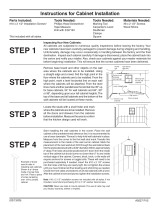
If you are thinking about, or have just purchased wood cabinetry, you’ll need to know how controlled indoor
humidity will keep your cabinets looking their absolute best all throughout the year!
A range of 30-55% humidity is important when outdoor temperatures range between 50 - 85 degrees. This
keeps your home comfortable and problem-free, with wood cabinetry looking and performing at its best.
Uncontrolled humidity extremes will likely cause problems within the home, particularly with cabinetry and
wood furniture pieces. Keep tabs on humidity levels with a digital hygrometer, available at many local retailers.
Indoor digital thermometers, often have a humidity gauge as well.
THE HOMEOWNERS’ GUIDE TO:
CABINETRY & HUMIDIFICATION
Should I be concerned during installation?
• MasterBrand recommends that our products be stored and installed in a temperate
atmosphere, where the humidity level and temperature are controlled.
• Allow cabinetry to acclimate to its new environment for a few days prior to installation.
This will minimize the degree that doors might swell or shrink, allowing them to return to
original dimensions once they have acclimated.
• Some remodeling or construction sites add to humidity levels when taping drywall,
pouring concrete, etc. These tasks must be completed prior to installation.
Steps to balance humidity levels in your home.
• Run heating, cooling and humidification systems consistently to maintain balance within the home.
• Make sure outside drainage is routed away from the home, and that vapor barriers
are properly installed.
• Proper insulation is key. Check with local contractors, HVAC specialists or the county
extension service for more information on how to achieve balance between moisture levels
and ventilation to achieve proper humidity levels in all seasons.
Prevent Damage
Important details to note!
• Dierent wood species react dierently to humidity than others.
• Products installed in non-air conditioned homes are susceptible to moisture imbalance.
Part-time residences (winter or summer homes) must maintain climate control at all times.
• Homeowners in high humidity climates must be vigilant about maintaining the proper indoor
humidity level.
Some expansion or contraction of wood products can occur and become noticeable when
cabinetry is moved from place to place or when weather conditions change, causing
humidity to fluctuate. In fact, most changes in wood appearance result from improper
humidity conditions during site storage, installation or actual use of the cabinetry.
Keep in Mind
© MasterBrand Cabinets 2018 masterbrand.com






